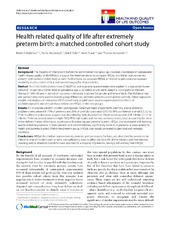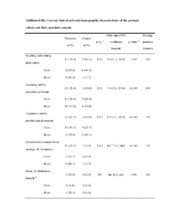| dc.contributor.author | Vederhus, Bente Johanne | en_US |
| dc.contributor.author | Markestad, Trond | en_US |
| dc.contributor.author | Eide, Geir Egil | en_US |
| dc.contributor.author | Graue, Marit | en_US |
| dc.contributor.author | Halvorsen, Thomas | en_US |
| dc.date.accessioned | 2011-04-20T08:37:39Z | |
| dc.date.available | 2011-04-20T08:37:39Z | |
| dc.date.issued | 2010-05-23 | eng |
| dc.identifier.issn | 1477-7525 | |
| dc.identifier.uri | https://hdl.handle.net/1956/4683 | |
| dc.description.abstract | Background: The majority of infants born before the last trimester now grow up. However, knowledge on subsequent health related quality of life (HRQoL) is scarce. We therefore aimed to compare HRQoL in children born extremely preterm with control children born at term. Furthermore, we assessed HRQoL in relation to perinatal and neonatal morbidity and to current clinical and sociodemographic characteristics. Method: The Child Health Questionnaire (CHQ-PF50) and a general questionnaire were applied in a population based cohort of 10 year old children born at gestational age ≤ 28 weeks or with birth weight ≤ 1000 grams in Western Norway in 1991-92 and in term-born controls, individually matched for gender and time of birth. The McNemar test and paired t-tests were used to explore group differences between preterms and matched controls. Paired regression models and analyses of interaction (SPSS mixed linear model) were used to explore potential effects of sociodemographic and clinical characteristics on HRQoL in the two groups. Results: All 35 eligible preterm children participated. None had major impairments. Learning and/or attention problems were present in 71% of preterms and 20% of controls (odds ratio (OR): 7.0; 95% confidence interval (CI): 2.2 to 27.6). Insufficient professional support was described by 36% of preterm vs. 3% of control parents (OR: infinite; CI: 2.7 to infinite). Preterms scored lower on eight CHQ-PF50 sub-scales and the two summary scores, boys accounting for most of the deficits in areas of behavior, psychosocial functioning and parental burden. HRQoL was associated with learning and/or attention problems in both preterm and control children, significantly more so in preterms in areas related to health and parental burden. Within the preterm group, HRQoL was mostly unrelated to perinatal and neonatal morbidity. Conclusions: HRQoL for children born extremely preterm, and particularly for boys, was described by parents to be inferior to that of children born at term, and sufficiently poor to affect the daily life of the children and their families. Learning and/or attention problems were reported for a majority of preterms, strongly influencing their HRQoL. | en_US |
| dc.language.iso | eng | eng |
| dc.publisher | BioMed Central | eng |
| dc.rights | Attribution CC BY | eng |
| dc.rights.uri | http://creativecommons.org/licenses/by/2.0 | eng |
| dc.title | Health related quality of life after extremely preterm birth: a matched controlled cohort study | en_US |
| dc.type | Peer reviewed | |
| dc.type | Journal article | |
| dc.description.version | publishedVersion | en_US |
| dc.rights.holder | Copyright 2010 Vederhus et al; licensee BioMed Central Ltd. | |
| dc.rights.holder | Vederhus et al. | |
| dc.identifier.doi | https://doi.org/10.1186/1477-7525-8-53 | |
| dc.identifier.cristin | 511186 | |
| dc.source.journal | Health and Quality of Life Outcomes | |
| dc.source.40 | 8 | |
| dc.source.14 | 53 | |
| dc.subject.nsi | VDP::Medical disciplines: 700 | eng |


